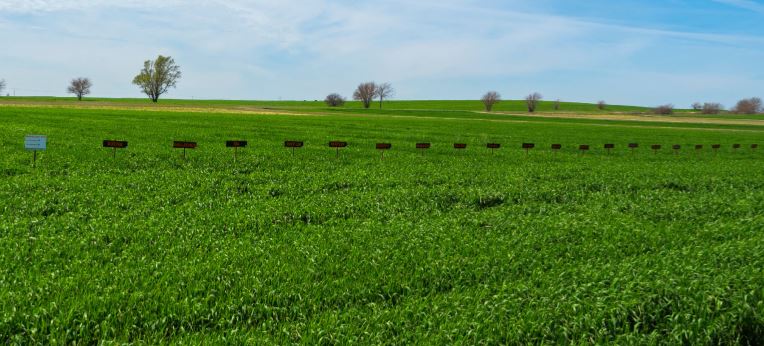
Oklahoma Wheat Commission’s Mike Schulte met with Oklahoma Farm Report’s Senior Farm and Ranch Broadcaster Ron Hays to discuss many of the topics covered in meetings during Schulte’s recent trip to Washington, D.C.
Schulte shared, “We have been having several discussions on the Food for Peace program, which has previously been housed under the U.S.A.I.D. (United States Agency for International Development), but those programs were set up in 1954 under President Eisenhower to find a way excess commodities in the United States to find other places to feed people in their time of need. We certainly think the work that goes on with U.S.A.I.D. and our International Food Aid programs with the USDA are important. Our goal is to help those people in their time of need, no matter what. I think there is a lot of debate about what the best way to do that is.”
Schulte’s goal is for agriculture to be involved in those debates, citing a loss of sight of the possibility of developing domestic markets while helping people in their time of need.
“As we have progressed with some of these programs over the last twenty years, we have seen less commodities being utilized by U.S. with the transfer of more cash donations to these countries in their time of need,” Schulte said. “Some of that has been brought up because there has been thought that we don’t want to create market distortion in these countries; if they have producers growing in this region, then we impact the price.”
Regarding wheat, several countries receiving aid lack the topography or climate to grow the crops themselves. Schulte’s hope is that by providing the commodities to the countries during their time of need, it opens a door for the country to become a buying customer once it is back on its feet. He described a House Resolution from Representative Tracey Mann and one in the Senate from Senator Jerry Moran, both of which were intent upon moving the Food for Peace program from U.S.A.I.D. to USDA.
“Specifically, we want a consistent program that works with American farmers and our domestic stakeholders that allows us to focus on research and technologies that help people in areas where climate and topography is a challenge, and allow us to still have market development opportunities to be at the forefront of innovation to help these countries and be a leader in feeding the world” Schulte detailed. “I think that the overall mission is that we want to help people build their economies up, but in our economy, here in the United States, at the forefront of things for research, innovation, and science as well.”
While in D.C., several state wheat commission leaders worked to inform and educate Senate and Congressional leaders about the value of their public research programs at various land grant institutions across the nation, as well as that of the USDA-ARS facilities in the country.
“We have a lot of work that goes on hand-in-hand through cooperations between USDA-ARS and our public land grant wheat research programs, and we just wanted to discuss the value of what those programs provide on return on investments to producers,” Schulte stated.
Then he continued, “Oftentimes, we don’t think producers realize the value of these variety releases and what all goes into it but just working on specific new strains of leaf rust or stripe rust – the hessian fly is a big issue in no-till situations in Oklahoma. We have several wheat varieties that come out of the OSU Public Research program that have hessian fly resistance and producers have certainly utilized those to their benefit in Central and Southern parts of the state of Oklahoma. None of that would have been possible without the researchers who are working on that in the ARS facilities that allow us to be able to deploy those traits into our wheat varieties that come out of the OSU Public Research Program.”
Wheat, Barley, and Sorghum Return on Investment (ROI) studies show a $419 ROI for every dollar spent for research, whether it be with the Russian wheat aphid, Greenbugs, bud trait oat aphids, leaf rust, or stripe rust. He detailed the amount of research that goes into the programs on the peanut side of things, most of which is taking place at the USDA-ARS facility in Oklahoma.
“We want to be working with those other commodity groups where that research is taking place specifically on the challenges that we are facing with continued drought and less water – specifically in Southwest and Central Oklahoma – and being able to breed drought-tolerant traits both into our wheat crops and our peanut crops where this research is taking place,” Schulte said.
He knows that producers have noticed the value of the research in their fields when crops possessing stripe rust and leaf rust resistant traits have allowed them additional time to apply fungicides in a timely manner, and when those crops produce 8 to 10 bushels per acre more than other varieties during years when those fungi were very prevalent.
He emphasized the importance of the OSU Public Research Program to Oklahoma producers and the chain of support that funds it, which begins with the wheat farmers supporting the Oklahoma Wheat Commission so that it may support the research program.
He noted the current challenges to wheat producers regarding low grain prices, drought, and policy concerns. “When you look at the support that we get through the commission and the value of that in what we have been able to provide producers with the varieties that we grow today, and we did not have twenty years ago with just specifics on drought-tolerant traits. It allows us to harvest something, when 25 years ago, given the weather conditions, we would not have had anything,” he said. “I think producers certainly do see the value of that research that is taking place.”
According to the March 2025 “Oklahoma Variety Report” from the USDA National Agricultural Statistics Service. For the seventh year in a row, the top five leading wheat varieties planted in the state were developed by OSU, with another three listed in the top eight this year. 12 of the top 25 varieties listed by the USDA report were developed by OSU. Over 49% of the wheat acres planted for the 2025 season are OSU-developed.
“There is certainly value in those programs and we want producers to realize that we are continually striving to work on things that are going to allow them to have better advancements on their farms, whether it be drought tolerance, nitrogen efficiency, and now there is specifically a lot of work going into short-season wheat so if producers do have to make that management decision to plant at the end of November or early December, they are going to have a wheat variety that they can put out there, and will hopefully harvest on time in June with the yield capability that they would have had with those other varieties,” Schulte pointed out.
He challenged producers to attend the wheat variety testing plot tours to see the variety options and how they perform. See the schedule of OSU wheat tours here.


















